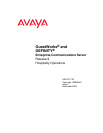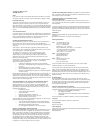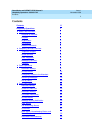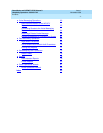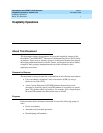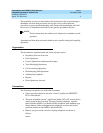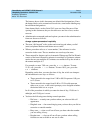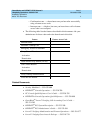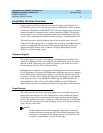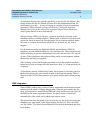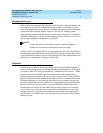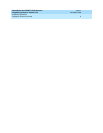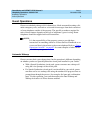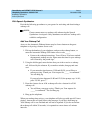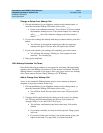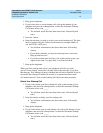Copyright
2000, Avaya Inc.
All Rights Reserved
Notice
Every effort was made to ensure that the information in this book was complete
and accurate at the time of printing. However, information is subject to change.
Preventing Toll Fraud
“Toll fraud” is the unauthorized use of your telecommunications system by an
unauthorized party (for example, a person who is not a corporate employee,
agent, subcontractor, or is not working on your company's behalf). Be aware that
there may be a risk of toll fraud associated with your system and that, if toll fraud
occurs, it can result in substantial additional charges for your telecommunications
services.
Avaya Fraud Intervention
If you suspect that you are being victimized by toll fraud and you need technical
assistance or support, in the United States and Canada, call the Technical Service
Center's Toll Fraud Intervention Hotline at 1-800-643-2353. Outside of the
United States and Canada, contact your Avaya representative.
Providing Telecommunications Security
Telecommunications security (of voice, data, and/or video communications) is
the prevention of any type of intrusion to (that is, either unauthorized or
malicious access to or use of your company's telecommunications equipment) by
some party.
Your company's “telecommunications equipment” includes both this Avaya
product and any other voice/data/video equipment that could be accessed via this
Avaya product (that is, “networked equipment”).
An “outside party” is anyone who is not a corporate employee, agent,
subcontractor, or is not working on your company's behalf. Whereas, a
“malicious party” is anyone (including someone who may be otherwise
authorized) who accesses your telecommunications equipment with either
malicious or mischievous intent.
Such intrusions may be either to/through synchronous (time-multiplexed and/or
circuit-based) or asynchronous (character-, message-, or packet-based)
equipment or interfaces for reasons of:
• Utilization (of capabilities special to the accessed equipment)
• Theft (such as, of intellectual property, financial assets, or toll-facil-
ity access)
• Eavesdropping (privacy invasions to humans)
• Mischief (troubling, but apparently innocuous, tampering)
• Harm (such as harmful tampering, data loss or alteration, regardless
of motive or intent)
Be aware that there may be a risk of unauthorized intrusions associated with your
system and/or its networked equipment. Also realize that, if such an intrusion
should occur, it could result in a variety of losses to your company (including but
not limited to, human/data privacy, intellectual property, material assets, financial
resources, labor costs, and/or legal costs).
Your Responsibility for Your Company’s Telecommunications Security
The final responsibility for securing both this system and its networked
equipment rests with you - an Avaya customer's system administrator, your
telecommunications peers, and your managers. Base the fulfillment of your
responsibility on acquired knowledge and resources from a variety of sources
including but not limited to:
• Installation documents
• System administration documents
• Security documents
• Hardware-/software-based security tools
• Shared information between you and your peers
• Telecommunications security experts
To prevent intrusions to your telecommunications equipment, you and your peers
should carefully program and configure your:
• Avaya-provided telecommunications systems and their interfaces
• Avaya-provided software applications, as well as their underlying
hardware/software platforms and interfaces
• Any other equipment networked to your Avaya products.
Federal Communications Commission Statement
Part 15: Class A Statement. This equipment has been tested and found to com-
ply with the limits for a Class A digital device, pursuant to Part 15 of the FCC
Rules. These limits are designed to provide reasonable protection against harm-
ful interference when the equipment is operated in a commercial environment.
This equipment generates, uses, and can radiate radio frequency energy and, if
not installed and used in accordance with the instruction manual, may cause
harmful interference to radio communications. Operation of this equipment in a
residential area is likely to cause harmful interference, in which case the user will
be required to correct the interference at his own expense.
Part 68: Network Registration Number. This equipment is registered with the
FCC in accordance with Part 68 of the FCC Rules. It is identified by FCC regis-
tration number AV1USA-43023-MF-E.
Canadian Department of Communications (DOC)
Interference Information
This digital apparatus does not exceed the Class A limits for radio noise emis-
sions set out in the radio interference regulations of the Canadian Department of
Communications.
Le Présent Appareil Nom
érique n’é
met pas de bruits radio
é
lectriques d
é
passant
les limites applicables aux appareils num
é
riques de la class A pr
é
scrites dans le
reglement sur le brouillage radio
é
lectrique
é
dict
é
par le minist
é
re des Communi-
cations du Canada.
Trademarks
DEFINITY and GuestWorks are registered trademarks of Avaya and Lucent
Technologies.
INTUITY is a trademark of Avaya and Lucent Technologies.
Ordering Information
Call: Avaya Publications Center
U.S. Voice: 1 888 582 3688
U.S. Fax: 1 800 566 9568
Canada Voice: +1 317 322 6619
Europe, Middle East, Africa Voice: +1 317 322 6416
Asia, China, Pacific Region, Caribbean,
Latin America Voice: +1 317 322 6411
Non-U.S. Fax: +1 317 322 6699
Write: Avaya Publications Center
2855 N. Franklin Road
Indianapolis, IN 46219
U.S.A.
Order: Document No. 555-231-742
Comcode 108898941
Issue 1, November 2000
For more information about Avaya documents, refer to the section entitled
“Related Documents” in “About This Document.”
You can be placed on a Standing Order list for this document and other docu-
ments you may need. Standing Order will enable you to automatically receive
updated versions of individual documents or document sets, billed to account
information that you provide. For more information on Standing Orders, or to be
put on a list to receive future issues of this document, please contact the Avaya
Publications Center.
Technical Support
In the United States and Canada, Avaya technicians and customers should
call 1-800-242-2121, and dealer technicians should call 1-877-295-0099. Outside
the United States and Canada, Avaya technicians should contact their Center of
Excellence (COE), and customers and dealer technicians should contact their
Avaya authorized representative.
European Union Declaration of Conformity
The “CE” mark affixed to the equipment described in this book indicates that the
equipment conforms to the following European Union (EU) Directives:
• Electromagnetic Compatibility (89/336/EEC)
• Low Voltage (73/23/EEC)
• Telecommunications Terminal Equipment (TTE) i-CTR3 BRI and
i-CTR4 PRI
For more information on standards compliance, contact your local distributor.
Comments
To comment on this document, return the comment form.
Avaya Web Page
http://www.avaya.com
Acknowledgment
This document was prepared by the Information Development Organization for
Global Learning Solutions
Bell Laboratories.



